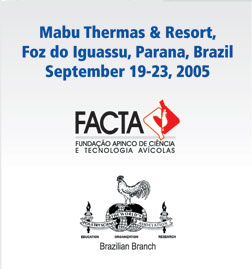Contributed Papers: Oral Presentations
Molecular biology and Biochemistry |
Acetyl CoA Carboxylase
in Avian Eimeria
P.C. Allen, K.B. Miska, M.C. Jenkins,
R.F. Fetterer.
USDA/ARS, Beltsville, Maryland, USA. pallen@anri.barc.usda.gov
Acetyl coA carboxylase,
catalyzes the first committed step in the biosynthesis
of fatty acids. In some apicomplexan parasites such
as Toxoplasma gondii and Plasmodium sp., a multi-domain
form of this enzyme (ACC 1) has been identified as
a nuclear-encoded protein that is transported to and
apparently functions in the apicoplast organelle found
in zoite stages of parasites life cycles. The unique
genetic origin of this enzyme and its apparent requirement
for parasite development suggests its potential as
a target for control of apicomplexan parasites. We
have therefore undertaken the characterization of
ACC1 in avian Eimeria. BLAST searches of both nucleotide
and protein data files from T. gondii ACC1 (tACC1)
precursor against the Sanger Institute Eimeria tenella
genome data base found a putative homolog Eimeria
ACC1 (eACC1) gene to be contained in Contig 5754,
and the carbamyl phosphate synthase, (5’end),
biotin binding, and carboxyl transferase (3’
end) domains were identified both through bioinformatics
as well as RT-PCR. The low genetic complexity of the
central portion of the eACC1 gene made its complete
sequencing difficult. A 224 nt sequence that is 73
nt upstream from the first exon common to tACC1 and
eACC1 was identified as a possible signal sequence
for eACC1. However, no tripartite leader sequence,
such as is found in tACC1 precursor that allows transport
of the protein into an apicoplast, was defined. These
observations, along with the lack of evidence for
an Eimerian apicoplast in the ultrastructure literature
suggest major differences between tACC1 and eACC1.
Expression of eACC1 protein was documented through
detection on polyacrylamide gels of a biotin-containing
protein band of about 250 kd. This band appears most
intense in merozoite extracts as compared to extracts
of oocysts and sporozoites. Determinations of differential
gene and protein expression of eACC1 among stages
of development are ongoing through use of RT-PCR and
Western blots of extracts.
